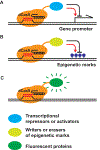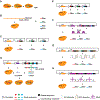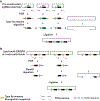The multiplexed CRISPR targeting platforms
- PMID: 30205881
- PMCID: PMC6699180
- DOI: 10.1016/j.ddtec.2018.01.001
The multiplexed CRISPR targeting platforms
Abstract
The discovery and engineering of the Clustered Regularly Interspaced Short Palindromic Repeats (CRISPR) in the past several years have revolutionized biomedical research. The CRISPR technology showed great potential to advance detection, prevention, and treatment of human diseases in the near future. Compared to previous developed genome editing approaches, such as zinc finger nucleases (ZFNs) and transcription activator-like effector nucleases (TALENs), the CRISPR-based systems have numerous advantages. One example is that the CRISPR systems can be easily adopted to efficiently target multiple genes simultaneously. Several strategies and toolboxes have been developed to achieve multiplexed targeting using the CRISPR systems. In this short review, we will discuss the principle, approach, and application of these strategies.
Copyright © 2018 Elsevier Ltd. All rights reserved.
Conflict of interest statement
Declaration of interest
None.
Figures




Similar articles
-
Genome editing: the road of CRISPR/Cas9 from bench to clinic.Exp Mol Med. 2016 Oct 14;48(10):e265. doi: 10.1038/emm.2016.111. Exp Mol Med. 2016. PMID: 27741224 Free PMC article. Review.
-
CRISPR/Cas9: an advanced tool for editing plant genomes.Transgenic Res. 2016 Oct;25(5):561-73. doi: 10.1007/s11248-016-9953-5. Epub 2016 Mar 24. Transgenic Res. 2016. PMID: 27012546 Review.
-
CRISPR/Cas9 technology as a potent molecular tool for gene therapy.J Cell Physiol. 2019 Aug;234(8):12267-12277. doi: 10.1002/jcp.27972. Epub 2019 Jan 30. J Cell Physiol. 2019. PMID: 30697727 Review.
-
Therapeutic editing of hepatocyte genome in vivo.J Hepatol. 2017 Oct;67(4):818-828. doi: 10.1016/j.jhep.2017.05.012. Epub 2017 May 17. J Hepatol. 2017. PMID: 28527665 Review.
-
Gene targeting technologies in rats: zinc finger nucleases, transcription activator-like effector nucleases, and clustered regularly interspaced short palindromic repeats.Dev Growth Differ. 2014 Jan;56(1):46-52. doi: 10.1111/dgd.12110. Epub 2013 Dec 27. Dev Growth Differ. 2014. PMID: 24372523 Review.
Cited by
-
Targeting miRNA by CRISPR/Cas in cancer: advantages and challenges.Mil Med Res. 2023 Jul 17;10(1):32. doi: 10.1186/s40779-023-00468-6. Mil Med Res. 2023. PMID: 37460924 Free PMC article. Review.
-
The Art of Finding the Right Drug Target: Emerging Methods and Strategies.Pharmacol Rev. 2024 Aug 15;76(5):896-914. doi: 10.1124/pharmrev.123.001028. Pharmacol Rev. 2024. PMID: 38866560 Free PMC article. Review.
-
Emerging therapies for refractory hypercholesterolemia: a narrative review.Future Cardiol. 2024 Apr 25;20(5-6):317-334. doi: 10.1080/14796678.2024.2367860. Epub 2024 Jul 10. Future Cardiol. 2024. PMID: 38985520 Free PMC article. Review.
-
Navigating the CRISPR/Cas Landscape for Enhanced Diagnosis and Treatment of Wilson's Disease.Cells. 2024 Jul 18;13(14):1214. doi: 10.3390/cells13141214. Cells. 2024. PMID: 39056796 Free PMC article. Review.
-
Breeding rice for yield improvement through CRISPR/Cas9 genome editing method: current technologies and examples.Physiol Mol Biol Plants. 2024 Feb;30(2):185-198. doi: 10.1007/s12298-024-01423-y. Epub 2024 Mar 8. Physiol Mol Biol Plants. 2024. PMID: 38623165 Free PMC article. Review.
References
Publication types
MeSH terms
Grants and funding
LinkOut - more resources
Full Text Sources
Other Literature Sources
Medical
Research Materials
Miscellaneous

